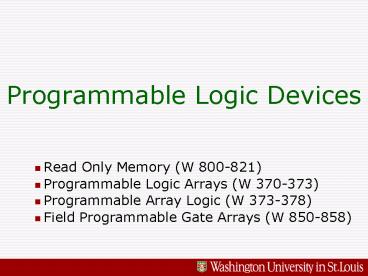Programmable Logic Devices - PowerPoint PPT Presentation
1 / 13
Title:
Programmable Logic Devices
Description:
store the logic function's truth table in memory ... PROMs are logically equivalent to PLA with AND-plane that generates all minterms ... – PowerPoint PPT presentation
Number of Views:64
Avg rating:3.0/5.0
Title: Programmable Logic Devices
1
Programmable Logic Devices
- Read Only Memory (W 800-821)
- Programmable Logic Arrays (W 370-373)
- Programmable Array Logic (W 373-378)
- Field Programmable Gate Arrays (W 850-858)
2
Implementation Options for Digital Logic
- Assembly of SSI and MSI parts on PC boards.
- mostly obsolete still useful when just a few
parts needed - Programmable Logic Devices (PLD)
- variety of types, with different size and
performance characteristics largest have over
106 gate equivalents - CAD tools enable simulation and automate device
programming - Application Specific Integrated Circuits (ASIC)
- design methods similar to PLDs
- HDLs and simulation with synthesis using standard
cell library - plus physical design - placement of logic
components, routing - can augment with custom design of critical
components - higher performance, greater logic density
- custom IC fabrication suitable for high
production volumes
3
Programmable Logic Devices
- Simple logic arrays
- implement 2 level logic circuits (AND/OR)
- based on regular array structure
- several types
- Read Only Memories (ROMs and PROMs)
- Programmable Logic Array (PLA)
- Programmable Array Logic (PAL)
- Field Programmable Gate Arrays (FPGA)
- many copies of common building block
- each block can be configured for different logic
functions and typically includes a flip flop and
a 4 input function generator - programmable interconnect
- often includes SRAM blocks
- largest FPGAs have about 100K flip flops, 100K
function generators and 10 Mb of SRAM
4
Read-Only Memory
- Any random access memory can implement logic.
- store the logic functions truth table in memory
- example use 4 bit RAM to get 2 input AND by
storing 0 at locations 00, 01, 10 and 1 at
location 11 - with 2m words of 1 bit each can implement any
logic function with m inputs - memory with 2m words of w bits each can implement
w different logic functions of same m inputs - Read-Only Memory (ROM) operates like a random
access memory, but cannot be written to. - stored data is determined when device is
manufactured - higher density and faster than comparable RAMs
- non-volatile storage - data retained when power
is off - programmable ROMs are written with PROM programmer
5
Implementation of ROMs
- ROM can be implemented using orthogonal
arrangement of wires. - optional connection at each intersection
- decoder puts logic 1 on exactly one of the
horizontal wires - this can be detected at output
if connection present - Some PROMs are configured by breaking
connections. - high voltage placed across one input and one
output at a time - high current flow causes fuse at intersection
to blow - Other PROMs can be erased and reprogrammed
(EPROMs).
- stored functions
- ?m(0,1,3,4,6), ?m(0,1,3,5,7), ?m(2,3,6,7),
?m(0,3,4,6)
6
Programmable Logic Arrays
- PLAs have configurable AND-plane OR-plane.
- Can implement any 2-level AND-OR circuit.
- Efficient physical implementation in CMOS.
7
Programmable Array Logic
- PAL is similar to PLA but fixed OR-plane.
- Simpler to program and cheaper implementation.
- Limited number of terms in each output.
8
Comparison of PROMs, PLAs PALs
- Can view PROMs, PALs as restricted forms of PLA.
- PROMs are logically equivalent to PLA with
AND-plane that generates all minterms and
configurable OR-plane - PAL is logically equivalent to PLA with fixed
OR-plane in which each output is the OR of a
subset of the ANDs - Different implementations means different
capabilities. - so, one needs to match device capabilities to the
characteristics of logic equations being
generated - consider number inputs outputs, total number of
different terms (PLAs), number of different terms
per output (PALs) - for given number of inputs/outputs, PROMs most
flexible - performance characteristics and cost also differ
- Most parts include flip flops, for sequential
circuits.
9
Field Programmable Gate Arrays
- FPGAs can be used to construct more complex
circuits. - Chip contains a large number (tens of thousands)
of configurable logic building blocks. - typically each block includes a 4 input function
generator, a flip flop and some glue logic - CAD tools map high level circuit to basic blocks,
configuring function generators other
configurable elements as needed - Programmable interconnect used to wire logic
blocks. - wire segments connected to logic blocks and to
other wire segments by configurable switches - CAD tools determine switch configuration needed
to provide right connectivity - CAD tools perform mapping, placement, routing.
- routing information used in timing analysis
simulation
10
Xilinx FPGA Organization
- CLBs can be connected to passing wires.
- Wire segments connected by switch matrix.
- Long wire segments used to connect distant CLBs.
- Configuration information stored in SRAM bits
that are loaded when power turns on.
11
Configuring Logic
- Lookup table implements logic functions.
- Multiplexors and pass transistors implement
routing. - Switch matrix contains configurable clusters of
pass transistors. - provides wide variety of routing options
12
Xilinx Configurable Logic Block
Clock EdgeSelect
Set/ResetControl
Clock EnableControl
Flip Flop
13
Implementing Serial Adder in CLB
CLK
EC
S/R
S/R C
LUT4
0
D
0110100101101101
PRE
gt
DIN
EC
CLR
H1
1
LUT4
XQ
0000000000010111
1
X
- Second flip flop still available (thru LUT3).

